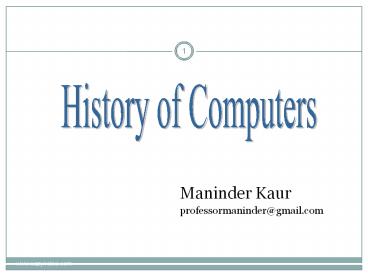Maninder Kaur professormaninder@gmail.com www.eazynotes.com - PowerPoint PPT Presentation
1 / 27
Title:
Maninder Kaur professormaninder@gmail.com www.eazynotes.com
Description:
Maninder Kaur professormaninder_at_gmail.com www.eazynotes.com * * AI studies include robotics, expert systems, games, etc. * A computer is an electronic machine that ... – PowerPoint PPT presentation
Number of Views:316
Avg rating:3.0/5.0
Title: Maninder Kaur professormaninder@gmail.com www.eazynotes.com
1
History of Computers
Maninder Kaur professormaninder_at_gmail.com
2
What is a Computer?
System Unit
A computer is an electronic machine that can be
programmed to accept data (input), process it
into useful information (output), and store it in
a storage media for future use.
3
History Evolution
Abacus
Mechanical Calculator
Difference Engine
Analytical Engine
1944 MARK I Howard Aiken at Harvard University
1951 - UNIVAC1 first commercial computer
1954 - Hewlett and Packard Met and setup shop in
Garage at Silicon valley
4
Abacus
5
- Difference Engine
- Analytical Engine
6
Mechanical Calculators
7
UNIVAC 1
8
1969 Internet was founded
1975 Microsoft Founded Bill Gates with Paul
Allen
1976 Apple
1981-IBM PC PC was introduced.
1989 WWW Invented by Tim Berners-Lee
9
1994 Netscape Founded by Jim Clark and Marc
Andreesen
Many more.
10
Computer Generations
- 1st Generation
- 2nd Generation
- 3rd Generation
- 4th Generation
- 5th Generation
11
1ST GENERATION (1944 - 1958) VACUUM TUBES
- Used thousand of vacuum tubes
- They were fastest calculating devices.
- Too large in size
- Large amount of heat due to thousands of vacuum
tubes, so air conditioning was required - High power consumption
12
1ST GENERATION (1944 - 1958) VACUUM TUBES
- High power consumption
- Frequent hardware failure due to burn out of
tubes - Costly to manufacture and maintain these
computers - The first computer using vacuum tubes was ENIAC
13
1ST GENERATION (1944 - 1958) VACUUM TUBES
IBM Punched Card (input)
Magnetic Tapes (output)
Vacuum Tubes (memory)
14
1ST GENERATION (1944 - 1958)
UNIVAC
ENIAC
15
2ND GENERATION (1959 - 1964) TRANSISTOR
- Use of transistors instead of vacuum tubes
- These transistors were made of solid material,
some of which is silicon, therefore they were
very cheap to produce - Easier to use and handle
- No burning out, but hardware failures were still
there - Almost ten times faster than tubes
- Much smaller than vacuum tubes and generate less
heat.
16
2ND GENERATION (1959 - 1964) TRANSISTOR
- Less expensive to produce but still costlier
- Produce less heat as compared to tubes but air
conditioning was required - High level programming languages such as FORTRAN,
COBOL were used - Easier to program these computers
- Batch operating system was used
17
2ND GENERATION (1959 - 1964) TRANSISTOR
18
3RD GENERATION (1964 - 1970) INTEGRATED CIRCUIT
- In 1958, Jack St. Clair Cilby Robert Noyce
invented integrated circuits - ICs consist of several electric components like
transistors, resistors and capacitors embedded on
a single chip of silicon - SSI, MSI technology
- More powerful faster than second generation
computers.
19
3RD GENERATION (1964 - 1970) INTEGRATED CIRCUIT
- Smaller in size and require small space for
installation - Require less power and produce less heat but
still need proper air conditioning - Faster and large memory
20
3RD GENERATION (1964 - 1970) INTEGRATED CIRCUIT
21
- 4TH GENERATION (1971- PRESENT) INTEGRATED CIRCUIT
- Use of ICs with VLSI technology Very Large-scale
integrated (VLSI). - Microprocessors and semiconductor memory
- Larger memory because of larger hard disks and
floppy disks and magnetic tapes as portable
storage media - Very less heat hence no air conditioning was
required instead fans were used
22
- 4TH GENERATION (1971-PRESENT)
- INTEGRATED CIRCUIT
- Graphical User Interface operating systems were
used - Very easy to manufacture maintain them and cost
very less - Very fast as compared to computers in early
generations - Microprocessors led to the invention of personal
computers.
23
4TH GENERATION (1971-PRESENT) MICROPROCESSOR
24
- 5th GENERATION
- PRESENT BEYOND
- ICs based on ULSI technology
- Portable PCs (notebook computers) were much
smaller and handy - Much faster and powerful than computers in
earlier generations - Consume very less power
25
- 5th GENERATION
- PRESENT BEYOND
- Less costlier and easy to manufacture and
maintain - Newer and more powerful applications make
computers more easy to use in every field - Artificial Intelligence (AI) concerns with making
computers behave and think like humans. - AI studies include robotics, expert systems,
games, etc..
26
5th Generation (Present Beyond) Artificial
Intelligence
27
THANK YOU































